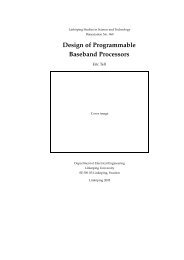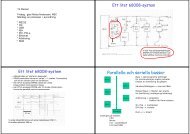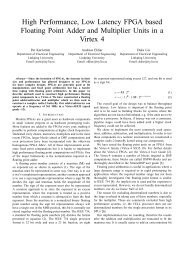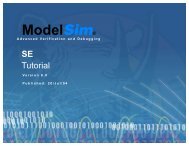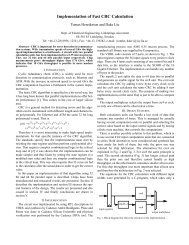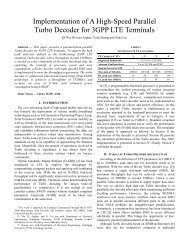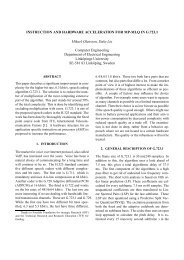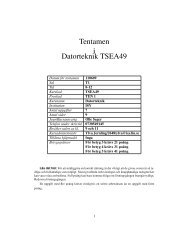Novel ASIP and Processor Architecture for Packet Decoding
Novel ASIP and Processor Architecture for Packet Decoding
Novel ASIP and Processor Architecture for Packet Decoding
You also want an ePaper? Increase the reach of your titles
YUMPU automatically turns print PDFs into web optimized ePapers that Google loves.
NOPNo operation, mostly used <strong>for</strong> aligning the data flow processing23 20 19 1800000 Buffer ctrl000000000000000000WATWait <strong>for</strong> inputs23 20 19 1800101 Buffer ctrlInput bitmapWaits until the general purpose inputs matches the input bitmap. All 19 inputs can be used to trigger the continuation of the programexecution.SETSet outputs23 20 19 1810 900010 Buffer ctrlNot usedOutput bitmapSets the general purpose outputs <strong>for</strong> one clock cycle. All 10 outputs can be set by using the bitmap.JMPJump23 20 19 18 17 16 13 12 11 10 9 8 700100 Buffer ctrl 00Not usedRelative offset0100 Buffer ctrl 01Input bitmapRelative offset0100 Buffer ctrl 10 Pointer Width Offset New Not used Relative offsetJumps to the relative offset specified in bits 7-0. Bits 18-17 decides the type of jump. Type 00 means unconditional. Type 01 meansconditional on the general purpose inputs. The bitmap in bits 16-8 corresponds to the inputs 8-0. Type 10 means conditional onmatch. Match is further described in the CMP instruction. The jump is taken if any of the parameters match the extracted fieldfrom the input buffer.CMPCompare23 20 19 18 1716 13 12 11 10 900001 Buffer ctrl NewJump Pointer Width Offset Not usedCompares the extracted field with the parameters. The parameters are stored in the PCB <strong>and</strong> the pointer points out the parametersto use. The field New indicates if the comparison is the continuation of the previous comparison or not. The field Jump indicates ifa jump should be conducted at a match. The field Width determines the width of the comparison, 4, 8, 16, or 32 bits. The field Offsetindicates how to extract the field from the input buffer.CPSCompare <strong>and</strong> set outputs23 20 19 1810 900011 Buffer ctrlAs <strong>for</strong> CMPAs <strong>for</strong> SETSets the outputs <strong>and</strong> per<strong>for</strong>ms a comparison.Figure 3: Detailed instruction <strong>for</strong>mat <strong>for</strong> all instructions
00000800 0 ffffffff 800000806 0c5a80ac00000000 0000000000000000 0000000000000011 1 0000ffff 900000000 00004ab700000000 0000000000000000 0000000000000000 2 82ec3705 1000000000 82ecffff00000000 ffffffff00000000 0000000000000000 3 000007e9 1100000000 0000000000000000 0000000000000000 0000000000000000 4 00000000 1200000000 0000000000000000 0000000000000000 0000000000000000 5 00000000 1300000000 0000000000000000 0000000000000000 0000000000000000 6 00000000 1400000000 0000000000000000 0000000000000000 0000000000000000 7 00000000 1500000000 0000000000000000 0000000000000000 00000000Figure 6: PCB contents <strong>for</strong> example programing packet is IP) outputs 2 <strong>and</strong> 6 are set. Output 2 triggers thelength counter accelerator <strong>for</strong> IP <strong>and</strong> output 6 stops the payloadstorage. For an IP/UDP packet only the UDP payload should bestored. For an ARP packet on the other h<strong>and</strong>, the whole Ethernetpayload is stored, since the data is needed by the microcontroller inorder to compile the ARP reply. Instruction 9 checks the protocolfield in the IP header <strong>and</strong> if it is 0x11 (UDP) a jump is done toinstruction 11. Instruction 11 is NOP <strong>and</strong> so is 12 (data flow aligning),but instruction 12 is the first (<strong>and</strong> only in this example) to usethe second word in the input buffer. This means that the last 64 bitsfrom the input will be available <strong>for</strong> instruction 13. This is alsoneeded, since instruction 13 is JMP with a compare of 32 bits withan offset of 16 bits, meaning that bits 47 down to 16 are extractedfrom the input buffer. In instruction 13 that is the IP destinationaddress, which is compared with PCB line 10. For a correct packet,then the UDP port is checked by instruction 15 <strong>and</strong> instruction 17triggers the payload storage to start again. After that, the headerhas been processed <strong>and</strong> the PP waits <strong>for</strong> inputs 5, 3, <strong>and</strong> 1 ininstruction 18. These three inputs indicate that the IP headerchecksum accelerator, the UDP checksum accelerator <strong>and</strong> the CRCaccelerator have completed their computations. In instruction 19 aconditional jump is done on inputs 6, 4, <strong>and</strong> 2. These are all 1 if thejust mentioned accelerators have received correct checksums.Then finally, the reception of a valid IP packet is acknowledgedthrough outputs 8 <strong>and</strong> 5 in instruction 21 <strong>and</strong> instruction 22 jumpsback to instruction 0 in order to wait <strong>for</strong> the next packet.If the Ethernet code was ARP, instructions 23 to 28 would haveexecuted in a similar manner. Whenever the received packet doesnot match the requirements the packet is discarded <strong>and</strong> the PPwaits <strong>for</strong> the next packet. This is done by a jump to instruction 3,which set output 6, discard payload, <strong>and</strong> then instruction 4 jumpsback to instruction 0.5. FUNCTIONAL COVERAGEAs mentioned earlier, the PP operates on a frame in-line, as it isreceived on the input port. There<strong>for</strong>e the PP operates, as planned,on one frame only <strong>and</strong> does not h<strong>and</strong>le any inter packet operations.The PP can h<strong>and</strong>le layer 2 protocols, like various Ethernet packet<strong>for</strong>mats, layer 3 protocols, like IP <strong>and</strong> layer 4 protocols, like UDP.For connection based protocols, like TCP <strong>and</strong> some wireless layer2 protocols, the PP supports the microcontroller by decoding theincoming packets. The microcontroller h<strong>and</strong>les the updating of theconnection state variables <strong>and</strong> the sending of packets. The PP canalso be used to decode any other packet stream, <strong>for</strong> exampledecoding MPEG control layer. The PP can be used in terminals asexplained in figure 1, but can also be used as a port accelerator in aswitch or a router. In these devices it is specially important withprogrammability, since system companies want to use their ownproprietary protocols to communicate between the switches <strong>and</strong>routers within a system. Although we have not been able to receivea specification <strong>for</strong> such a protocol, we cannot see any obstacle <strong>for</strong>using the PP to decode it.The PP has four parameters in each line of the PCB <strong>and</strong> CCB. Thislimits the number of ports etc. that can be h<strong>and</strong>led. If there is aneed <strong>for</strong> more parameters, the PCB <strong>and</strong> CCB can be made widerfollowing the trade off of per<strong>for</strong>mance <strong>and</strong> silicon area.The functional verification of the PP, was divided into three kindsof test cases, single instruction based, <strong>for</strong>mal functions <strong>and</strong> errorinjections.5.1. Single Instruction Based VerificationThe single instruction based verification <strong>for</strong> the PP differs fromthat of a traditional processor. Since there are no target registers <strong>for</strong>the instructions, there is only the program counter <strong>and</strong> the outputs,that can prove the correctness of the implementation. The WAT,JMP, CMP, <strong>and</strong> CPS instructions all influence the program counter.The CPS <strong>and</strong> SET instructions influence the outputs. All instructionscan influence the buffer content.The coverage of the verification is dependent on two parts, the controlsignals <strong>and</strong> the data pattern. The control signals are decided bythe instruction in the ILT <strong>and</strong> the CCB content. The data pattern isdecided by the content in the PCB <strong>and</strong> the received packet. Foreach instruction all possible correlated control signal combinationswere listed <strong>and</strong> <strong>for</strong> them where the data pattern influences the outcomeof the execution corner cases were selected.The VHDL model of the PP was extended with a non-synthesiz-
able part which writes the PC <strong>and</strong> the outputs <strong>and</strong> the input bufferto a file every clock cycle <strong>for</strong> verification purposes only. For allinput combinations, corresponding reference files were manuallycreated in order to simplify the verification task.OutputsData InputThis covers most of the RTL code, but of course the coverage isnot 100%. Control signals that do not interfere were not tested inall combinations <strong>and</strong> all data patterns were not used, since thatwould have required too much time.5.2. Formal Functions VerificationFor the verification of the <strong>for</strong>mal functions, the example programfrom section 4 was used. It covers the following functions as basic<strong>and</strong> kernel functions <strong>for</strong> a general purpose protocol processor:• Synchronize the processing based on in<strong>for</strong>mation from thephysical interface• Match packet header field to several acceptable values• Demultiplex packet processing based on upper layer protocol• Use checksums to assure that no transmission errors haveoccurred• H<strong>and</strong> over a correct packet payload to the application processingThe reception processing was first modelled in C++ at a behaviorallevel. Then a structural C++ model was developed, which executesthe instruction set in a cycle true manner. The simulation needsfour inputs, the ILT content, the PCB content, the CCB content <strong>and</strong>the received packet. The structural model was then manually transferredinto a VHDL model, which is used <strong>for</strong> implementation. Thetestbench <strong>for</strong> the VHDL model use the same stimuli files as theC++ model <strong>and</strong> thereby the VHDL was verified efficiently.5.3. Error InjectionTo make sure that the PP executes all program branches correctly,packets with various errors were injected into the simulation.These faulty packets cover the following errors:• Ethernet destination address that is not <strong>for</strong> the host• IP destination address that is not <strong>for</strong> the host• Ethernet code which is not IP or ARP• IP protocol which is not UDP• UDP port which is not 2025• Wrong IP header checksum• Wrong UDP checksum• Wrong Ethernet CRCThe resulting operation was checked in the GUI of the simulator.6. IMPLEMENTATIONThe VHDL model described in the previous section was used <strong>for</strong>the implementation. The model contains the part of the PP thatexecutes the instructions, the configuration interface <strong>and</strong> 5 accelerators.The microcontroller can access the ILT, the PCB, <strong>and</strong> theCCB via an SRAM interface. The lookup tables are implementedby flip-flops. The microcontroller finishes the configuration of thePP by writing data to the first position in the ILT, which triggersthe start of program execution in the PP. Figure 7 provides a blockdiagram of the PP. PC is the program counter, ID is the instructiondecoder, NextPC is the unit that calculates the next PC value basedIDILTPCPCBInput BufferCompare UnitCCBNextPCFigure 7: PP block diagramInputson the control signals from the ID, the output from the CCB <strong>and</strong>the inputs to the PP. The configuration interface <strong>and</strong> the acceleratorsare not shown in the figure.The accelerators that were used were an Ethernet CRC accelerator,an IP header checksum accelerator, a UDP checksum accelerator, apacket length counter <strong>and</strong> a memory interface unit.The PP was synthesized to a 6 metal layer 0.18 micron libraryfrom UMC in order to get an accurate estimate of the per<strong>for</strong>mance.Cadence Envisia PKS was used <strong>for</strong> the synthesis <strong>and</strong> placement ofthe st<strong>and</strong>ard cells.7. RESULTS AND DISCUSSIONAll results are estimations after synthesis <strong>and</strong> placement. The PPuses an area of 0.4 mm 2 without the accelerators. The acceleratorshave previously been implemented [7], [8], [9]. The three lookuptables, that totally contain 3072 flip-flops use more than half of thetotal PP area. The lookup tables can be implemented with memorymacro blocks instead of st<strong>and</strong>ard cell flip-flops, which woulddecrease the area consumption even further.The delay in the critical path is 3.43 ns <strong>and</strong> with a setup time of0.12 ns, a minimum cycle time of 3.55 ns can be used. This correspondsto a maximum clock frequency of 281 MHz <strong>and</strong> the PP canthus support a data stream at more than 9 Gb/s, since 32 bits areprocessed every clock cycle. There<strong>for</strong>e, when implementing thePP in a 0.13 micron process we have clear indications that the PPwill support a data stream of more than 10 Gb/s.The critical path is from the PC, through the ILT, the PCB, the
compare units, the CCB <strong>and</strong> an adder back to the PC. The delayfrom the parts can be seen in table 1.Techniques in order to reduce the delay of the critical path, such asflip-flop cloning, have not been used since there is only a need tosupport st<strong>and</strong>ard network speeds such as 10 Gb/s <strong>and</strong> that will bemanaged by using a 0.13 micron technology.8. RELATED WORKSeveral publications exist which address the topic of off-loadingthe protocol processing from the host processor, <strong>for</strong> example [4],[2] <strong>and</strong> [1]. There are also many companies working in this area,iReady, Alacritech, Intel, Agilent, Silverback, Trebia are someexamples. From the companies limited in<strong>for</strong>mation on the detailedimplementation is available.Typical <strong>for</strong> all published work is that it uses traditional RISC-likeprocessors <strong>for</strong> the protocol processing off-loading. For example, in[2] a 133 MHz general purpose RISC processor was used. We havedesigned a completely new processor architecture <strong>and</strong> ISA, whichis dedicated <strong>for</strong> protocol decoding <strong>and</strong> there<strong>for</strong>e can reach per<strong>for</strong>manceas high as 10 Gigabit/s. The other solutions aim at GigabitEthernet <strong>and</strong> with the RISC-like processor it will be hard toincrease the per<strong>for</strong>mance 10 times, although some of the start-upspromise scalable designs. On the other h<strong>and</strong> some other solutionsmanage the complete TCP protocol <strong>for</strong> example, our PP h<strong>and</strong>lesonly the decoding of received packets. There<strong>for</strong>e our processor canbe seen as a part of a TCP off-loading engine. Combined withother specialized processors it can constitute a complete off-loadingengine <strong>for</strong> 10 Gigabit Ethernet.The RISC processor based implementations assume that the packetis stored in a memory. Our processor on the other h<strong>and</strong> operates atthe packet be<strong>for</strong>e it is stored in memory. If it can be decoded fromthe packet header that the packet should not be processed further,the packet payload is never stored in the memory at all. This savesmemory b<strong>and</strong>width <strong>and</strong> power consumption.9. CONCLUSIONSA protocol processor <strong>for</strong> in-line packet decoding has beendesigned <strong>and</strong> implemented. The instruction set consists of only 6instructions, but they support many variations which allowsenough flexibility. The processor has been implemented in a 0.18micron technology <strong>and</strong> static timing analysis per<strong>for</strong>mance estimationindicates that the processor can support 9 Gb/s data streams.Table 1. DelaysPartDelay [ns]PC (Clk to Q) 0.21ILT 0.74PCB 0.86compare <strong>and</strong> CCB 1.16Adder (NextPC) 0.46Setup 0.12Total cycle time 3.55Future work includes the integration of the processor into anFPGA-based demonstrator <strong>for</strong> audio reception <strong>and</strong> implementationin a 0.13 micron technology <strong>for</strong> more accurate per<strong>for</strong>mance analysis.Evaluations <strong>and</strong> optimizations of processor word length, programmemory size <strong>and</strong> processor internal parallelism in thecomparator array are also planned. Further on a compiler will bedeveloped.10. REFERENCES[1] Alacritech, Delivering High-Per<strong>for</strong>mance Storage Networking,Alacritech whitepaper, on the www: http://www.alacritech.com/[2] P. Buonadonna, D. Culler, Queue Pair IP: A Hybrid <strong>Architecture</strong><strong>for</strong> System Area Networks, International Symposiumon Computer <strong>Architecture</strong> 2002, pp. 247-256, June 2002,Anchorage, Alaska[3] W. Bux, W. E. Denzel, T. Engbersen, A. Herkersdorf, <strong>and</strong> R.P. Luijten, Technologies <strong>and</strong> Building Blocks <strong>for</strong> Fast <strong>Packet</strong>Forwarding, IEEE Communications Magazine, Vol. 31,No. 1, Jan 2001, pp. 70-77[4] L. Gwennap, Count on TCP offload engine, EETimes, on thewww: http://www.eetimes.com/semi/c/ip/OEG20010917S0051[5] T. Henriksson, U. Nordqvist, <strong>and</strong> D. Liu, Embedded Protocol<strong>Processor</strong> <strong>for</strong> Fast <strong>and</strong> Efficient <strong>Packet</strong> Reception, in InternationalConference on Computer Design 2002, pp. 414-419, September 16-18, 2002, Freiburg, Germany[6] T. Henriksson, D. Liu <strong>and</strong> H. Bergh, METHOD AND AP-PARATUS FOR GENRAL-PURPOSE PACKET RECEP-TION PROCESSING, US Patent application no. 09/934372[7] T. Henriksson, H. Eriksson, U. Nordqvist, P. Larsson-Ede<strong>for</strong>s,D. Liu, VLSI IMPLEMENTATION OF CRC-32 FOR10 GIGABIT ETHERNET, in Proceedings of InternationalConference on Electronics, Circuits <strong>and</strong> Systems 2001, volIII, pp. 1215-1218, September 2-5, 2001, Malta[8] T. Henriksson, N. Persson, D. Liu, VLSI IMPLEMENTA-TION OF INTERNET CHECKSUM CALCULATIONFOR 10 GIGABIT ETHERNET, in Proceedings of Design<strong>and</strong> Diganostics of Electronics, Cricuits <strong>and</strong> Systems, pp.114-121, April 17-19, 2002, Brno, Czeck Republic[9] T. Henriksson, U. Nordqvist, D. Liu, Specification of a configurableGeneral-Purpose Protocol <strong>Processor</strong>, IEE Proceedingson Circuits, Devices <strong>and</strong> Systems, Vol 149, No. 3,2002, pp. 198-202[10] J. Williams, <strong>Architecture</strong>s <strong>for</strong> Network Processing, InternationalSymposium on VLSI Technology, Systems, <strong>and</strong> Applications2001, pp. 61-64[11] T. Wolf <strong>and</strong> J. S. Turner, Design Issues <strong>for</strong> High-Per<strong>for</strong>manceActive Routers, IEEE Journal on Selected Areas inCommunications, Vol. 19, No. 3, March 2001, pp. 404-409




